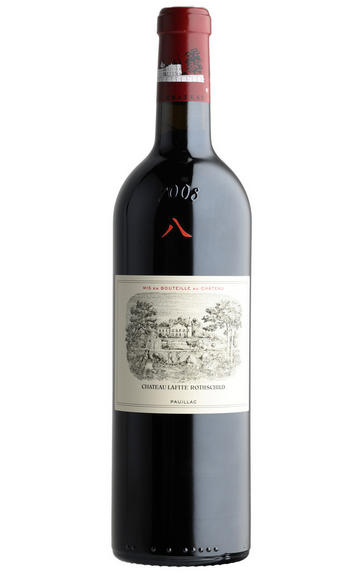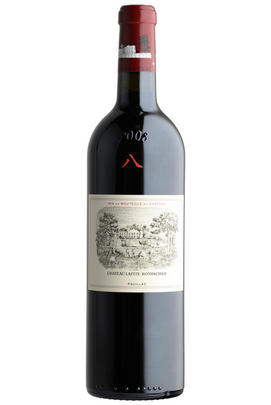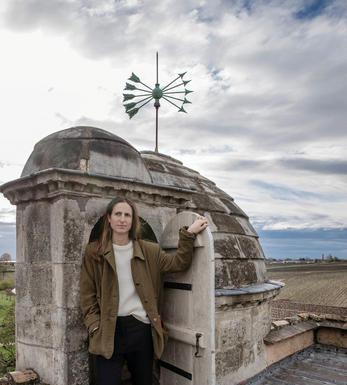
2022 Château Lafite Rothschild, Pauillac, Bordeaux

Critics reviews
Saturated inky colour, with intense ruby reflections. This is a classically constructed Lafite, with clear power to the tannins and intense spice, a little more upfront and concentrated than you find in many En Primeur vintages at this property but it exemplifies balance and confidence. Fully in control, delivering estate signature with finesse and understatement, with pulses of graphite, slate, bitter almond and cocoa bean.
Takes its time to uncurl in the glass, leaving you plenty of time to admire its architecture. Give it a good decade at least. 17.5% of press wine, 3.85ph, 41% Lafite of overall production. Harvest August 31 to September 24, earliest since 1893. 100% new oak, Eric Kohler techincal director. Potential upscore in bottle.
Drink 2032 - 2052
Jane Anson, JaneAnson.com (April 2023)
A blend of 94% Cabernet Sauvignon, 5% Merlot and 1% Petit Verdot, the 2022 Lafite Rothschild unwinds in the glass with aromas of dark berries, cassis, sweet soils tones, cigar box and lilac. Medium to full-bodied, it's the most tensile of the first growths this year, with a layered, concentrated but youthfully introverted mid-palate, lively acids and a long, saline finish. It checks in at a rather high pH of 3.85, which belies its incisive profile, from a harvest that extended from August 31 to September 24.
William Kelley, Wine Advocate (April 2023)
The 2022 Château Lafite-Rothschild is based on 94% Cabernet Sauvignon, 5% Merlot, and 1% Petit Verdot that was harvested between the 31st of August and the 24th of September. It's a richer, more opulent wine compared to the more classic 2020 (although the pH is higher in the 2020) and has a deep, full-bodied, concentrated profile as well as classic Lafite aromatics of spicy red and black fruits, freshly sharpened pencils, graphite, and tobacco.
Deep, rich, and concentrated, it nevertheless stays pure and flawlessly balanced, with ample, ripe tannins and a great finish. It's going to have some up-front appeal by Lafite standards but should still require a decade of bottle age. Director Eric Koher compares this to the 2005, but this modern-day clone of the 1959 is one of the most powerful, concentrated Lafites I've tasted.
Jeb Dunnuck, JebDunnuck.com (May 2023)
About this WINE

Château Lafite Rothschild
The iconic Château Lafite Rothschild was classified as a first growth in 1855 and has been in the Rothschild family since 1868. Today, Lafite is headed up by Saskia de Rothschild, daughter of long-time steward Baron Eric de Rothschild.
Château Lafite Rothschild is an iconic first-growth property in the Pauillac appellation of Bordeaux, France. It achieved its top-tier rank in 1855 and has been in the Rothschild family since 1868. Today, Lafite is headed up by Saskia de Rothschild, daughter of long-time steward Baron Eric de Rothschild.
The property is located at the northern tip of Pauillac, separated by St Estèphe by marshland and the Jalle de Breuil stream. Two areas of the vineyard are particularly notable: the gravel plateau, which is the heart of the grand vin; and the Plateau de Carruades, from which Lafite’s second wine takes its name. The vineyard is planted mostly to Cabernet Sauvignon (70%), along with Merlot (25%), Cabernet Franc (3%) and Petit Verdot (2%).
A new cellar was completed here in time for the 2011 harvest, with a combination of stainless steel and concrete tanks, of varying sizes. The barrels come from Lafite’s own cooperage, located not far from the property.
In addition to its 110 hectares of vines, the estate has 300 hectares of woods and marshes. The team consider this to be an integral part of the ecosystem.

Pauillac
Pauillac is the aristocrat of the Médoc boasting boasting 75 percent of the region’s First Growths and with Grand Cru Classés representing 84 percent of Pauillac's production.
For a small town, surrounded by so many familiar and regal names, Pauillac imparts a slightly seedy impression. There are no grand hotels or restaurants – with the honourable exception of the establishments owned by Jean-Michel Cazes – rather a small port and yacht harbour, and a dominant petrochemical plant.
Yet outside the town, , there is arguably the greatest concentration of fabulous vineyards throughout all Bordeaux, including three of the five First Growths. Bordering St Estèphe to the north and St Julien to the south, Pauillac has fine, deep gravel soils with important iron and marl deposits, and a subtle, softly-rolling landscape, cut by a series of small streams running into the Gironde. The vineyards are located on two gravel-rich plateaux, one to the northwest of the town of Pauillac and the other to the south, with the vines reaching a greater depth than anywhere else in the Médoc.
Pauillac's first growths each have their own unique characteristics; Lafite Rothschild, tucked in the northern part of Pauillac on the St Estèphe border, produces Pauillac's most aromatically complex and subtly-flavoured wine. Mouton Rothschild's vineyards lie on a well-drained gravel ridge and - with its high percentage of Cabernet Sauvignon - can produce (in its best years) Pauillac's most decadently rich, fleshy and exotic wine.
Latour, arguably Bordeaux's most consistent First Growth, is located in southern Pauillac next to St Julien. Its soil is gravel-rich with superb drainage, and Latour's vines penetrate as far as five metres into the soil. It produces perhaps the most long-lived wines of the Médoc.
Recommended Châteaux
Ch. Lafite-Rothschild, Ch. Latour, Ch. Mouton-Rothschild, Ch. Pichon-Longueville Baron, Ch. Pichon Longueville Comtesse de Lalande, Ch. Lynch-Bages, Ch. Grand-Puy-Lacoste, Ch, Pontet-Canet, Les Forts de Latour, Ch. Haut-Batailley, Ch. Batailley, Ch. Haut-Bages Libéral.

Cabernet Sauvignon Blend
Cabernet Sauvignon lends itself particularly well in blends with Merlot. This is actually the archetypal Bordeaux blend, though in different proportions in the sub-regions and sometimes topped up with Cabernet Franc, Malbec, and Petit Verdot.
In the Médoc and Graves the percentage of Cabernet Sauvignon in the blend can range from 95% (Mouton-Rothschild) to as low as 40%. It is particularly suited to the dry, warm, free- draining, gravel-rich soils and is responsible for the redolent cassis characteristics as well as the depth of colour, tannic structure and pronounced acidity of Médoc wines. However 100% Cabernet Sauvignon wines can be slightly hollow-tasting in the middle palate and Merlot with its generous, fleshy fruit flavours acts as a perfect foil by filling in this cavity.
In St-Emilion and Pomerol, the blends are Merlot dominated as Cabernet Sauvignon can struggle to ripen there - when it is included, it adds structure and body to the wine. Sassicaia is the most famous Bordeaux blend in Italy and has spawned many imitations, whereby the blend is now firmly established in the New World and particularly in California and Australia.


Buying options
Add to wishlist
Description
Saturated inky colour, with intense ruby reflections. This is a classically constructed Lafite, with clear power to the tannins and intense spice, a little more upfront and concentrated than you find in many En Primeur vintages at this property but it exemplifies balance and confidence. Fully in control, delivering estate signature with finesse and understatement, with pulses of graphite, slate, bitter almond and cocoa bean.
Takes its time to uncurl in the glass, leaving you plenty of time to admire its architecture. Give it a good decade at least. 17.5% of press wine, 3.85ph, 41% Lafite of overall production. Harvest August 31 to September 24, earliest since 1893. 100% new oak, Eric Kohler techincal director. Potential upscore in bottle.
Drink 2032 - 2052
Jane Anson, JaneAnson.com (April 2023)
wine at a glance
Delivery and quality guarantee